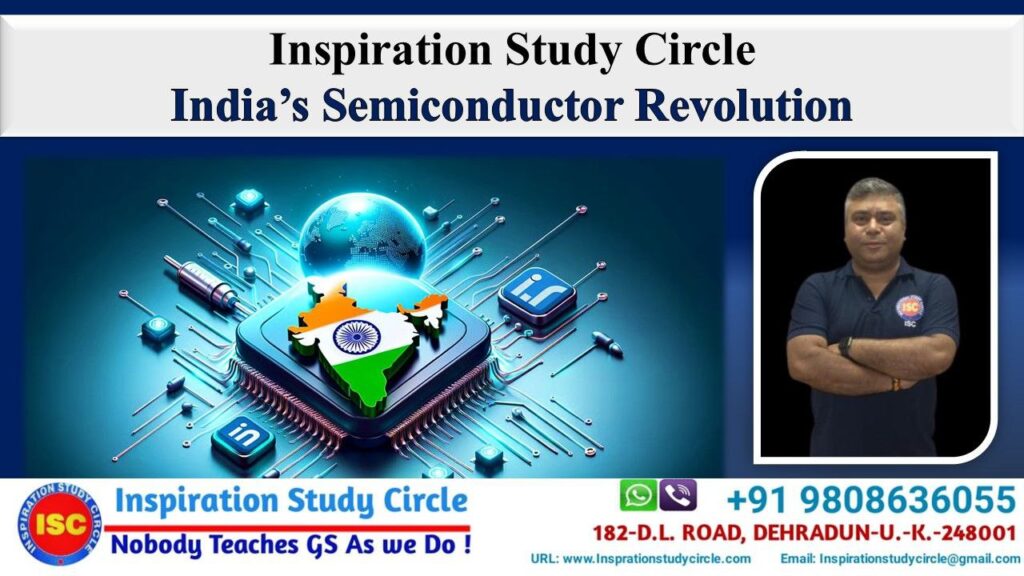India’s Semiconductor Revolution
The India Semiconductor Mission (ISM) aims to build a strong semiconductor and display ecosystem, positioning India as a global hub for electronics manufacturing and design, while serving as the nodal agency for the efficient and seamless implementation of semiconductor and display schemes.

What is a Semiconductor?
- A semiconductor is a material whose electrical conductivity lies between that of conductors and insulators, allowing it to act as either under different conditions
- These unique properties make semiconductors ideal for use in tiny electronic components that function as the brains of modern devices.
- Semiconductors are used to create electronic chips that control how devices function.
- Each chip contains millions or even billions of tiny switches called transistors that control electrical signals, similar to how brain cells work.
- Chips also contain other components such as resistors, capacitors, and wiring to help store, process, and transfer information.
Semiconductors are fundamental to today’s digital economy, powering everything from smartphones and automobiles to defense and medical devices. India has made remarkable progress in strengthening its semiconductor ecosystem, driven by the vision of Aatmanirbhar.
With the launch of the India Semiconductor Mission and an outlay of ₹76,000 crore, several fabrication and design facilities have been established, propelling the country towards technological leadership and reduced import dependence. Recent government approvals and investments signify India’s emergence as a global hub for electronics and semiconductor manufacturing, underscoring its commitment to self-reliance and innovation.
Major Milestones in India’s Semiconductor Revolution
- 2021: Union Cabinet approved the India Semiconductor Mission (ISM) with a ₹76,000 crore outlay to boost fabrication, design, and manufacturing.
- 2023–2025: Rapid setup of major facilities by domestic and foreign firms with significant investments. Total approved projects under ISM reach 10 with cumulative investments of around Rs 1.60 lakh crore in 6 states.
- 2025: India inaugurated its first centers for advanced 3-nanometer chip design in Noida and Bengaluru, an Indian first.
- At the Global Investors Summit 2025, it was announced that India’s first indigenous semiconductor chip would be ready for production this year. Five production units are under construction, signalling a significant milestone for domestic capability.
- Madhya Pradesh has made a significant stride in the IT and electronics sector with the inauguration of its first IT campus, backed by an investment of ₹150 crore over the next six years.
- In July 2025, Netrasemi, a startup supported under the government’s chip design scheme, received Venture Capital (VC) investment of ₹107 crore. The company is developing chips for smart vision, CCTV cameras, and Internet of Things (IoT) applications.
- In fabrication, India is moving from traditional silicon-based semiconductors to the latest Silicon carbide-based semiconductors. In design, the roadmap is to introduce the more advanced 3D Glass packaging technology. Such technology is critical for sectors like defence systems, missiles, radars & rockets in space.
Significance of the Semiconductor Industry
Semiconductors are at the heart of modern technology. They power essential systems in healthcare, transport, communication, defence, and space. As the world moves toward greater digitalization and automation, semiconductors have become integral to economic security and strategic independence. We can recall the acute shortage of chips that the world faced following the COVID-19 pandemic and the Ukraine-Russia war that affected the manufacturing of cars, mobile phones, and other electronics. The main drivers of growth in the semiconductor industry include the accelerating pace of digitization across sectors, which is increasing the demand for faster, more efficient, and compact electronic components. There is a growing reliance on advanced semiconductor-based systems to process and store vast amounts of data generated by digital platforms, smart devices, and connected infrastructure. The rapid adoption of artificial intelligence and machine learning, both at the edge and in cloud data centres, is fuelling the need for high-performance, energy-efficient chips that can handle complex computing tasks in real time. Currently, countries like Taiwan, South Korea, Japan, China, and the US dominate the semiconductor industry. Taiwan produces more than 60% of the world’s semiconductors, including nearly 90% of the most advanced ones.1 Such dependence on a single region has exposed global supply chains to significant risks—from pandemics and natural disasters to geopolitical tensions. Recognizing this challenge, many countries are now building secure and diversified supply chains. The United States, European Union, Japan, and South Korea have launched national strategies to support domestic chip manufacturing and reduce over-reliance on a single region. India is emerging as an important and trusted partner in this global shift.
India and the Semiconductor Market
The global demand for chips is skyrocketing, but the supply chain remains very fragile owing to the concentration of the industry in a few limited geographies. There is a clear need for global diversification of manufacturing. India is emerging as a dominant player in this regard. Initiatives like including Electronics Systems Design and Manufacturing (ESDM) as one of the key sectors under Make in India, or the India Semiconductor Mission and Semicon India programme, have helped create an ecosystem to support the industry. The global semiconductor market is expected to reach USD 1 trillion by 2030, with India’s market occupying a substantial portion of it.2 India can emerge as a key contributor to the 3 primary pillars of the semiconductor manufacturing supply chain – Equipment – leveraging strong base of MSMEs to produce components for semiconductor equipment: Materials – India is a rich source of chemicals, minerals and gases which semiconductor supply chain companies can utilize; and Services (R&D, Logistics and supply chain, major talent in AI, big data, cloud computing, etc.
In May 2025, the Union Minister for Electronics & IT, Railways, and Information & Broadcasting, Shri Ashwini Vaishnaw, inaugurated two state-of-the-art semiconductor design facilities in Noida and Bengaluru. These centres are India’s first to focus on advanced 3-nanometer chip design, marking a significant milestone in the nation’s semiconductor innovation journey. Highlighting the achievement, the Minister stated that designing at 3 nanometers is truly next-generation, noting that while India had previously achieved 7nm and 5nm designs, this development marks a new frontier in semiconductor innovation.
India Semiconductor Mission (ISM)
The India Semiconductor Mission was approved by the Union Cabinet in December 2021. With an outlay of ₹76,000 crore, the programme aims to provide financial support for investments in semiconductor fabrication, display manufacturing & chip design to strengthen India’s integration into global electronics value chains. Envisioned to be led by global experts in the Semiconductor and Display industry, ISM aims to build a strong semiconductor and display ecosystem, positioning India as a global hub for electronics manufacturing and design, while serving as the nodal agency for the efficient and seamless implementation of semiconductor and display schemes.
Main focus of ISM
- Set up Chip Manufacturing plants(fabs)
- Create packaging and testing units
- Supporting startups in chip design
- Training young engineers
- Bring Global companies to invest in India
Objectives of ISM
- Formulate a long-term strategy for developing sustainable semiconductors and display manufacturing facilities and a semiconductor design eco-system in the country.
- Facilitate the adoption of secure microelectronics and develop a trusted semiconductor supply chain, including raw materials, specialty chemicals, gases, and manufacturing equipment.
- Enable a multi-fold growth of the Indian semiconductor design industry by providing requisite support in the form of Electronic Design Automation (EDA) tools, foundry services, and other suitable mechanisms for early-stage start-ups.
- Promote and facilitate indigenous Intellectual Property (IP) generation.
- Encourage, enable, and incentivize Transfer of Technologies (ToT).
- Establish suitable mechanisms to harness economies of scale in the Indian semiconductor and display industry.
- Enable cutting-edge research in semiconductors and the display industry, including evolutionary and revolutionary technologies through grants, global collaborations, and other mechanisms in academia/research institutions, industry, and through establishing Centres of Excellence (CoEs).
- Enable collaborations and partnership programs with national and international agencies, industries, and institutions for catalyzing collaborative research, commercialization, and skill development
Schemes under ISM
- Semiconductor Fabs Scheme: This scheme provides up to 50% fiscal support for setting up semiconductor wafer fabrication (fab) units in India. It targets advanced nodes such as 28nm or below, as well as mature technologies. The goal is to establish high-tech, large-scale fabs that serve both domestic and global demand.
- Display Fabs Scheme: Offers financial assistance of up to 50% of the project cost to set up display fabrication units in India. It covers technologies such as AMOLED and LCD displays, aiming to reduce import dependence and promote domestic innovation in next-gen display manufacturing.
- Compound Semiconductors and ATMP/OSAT Scheme: Supports setting up units for compound semiconductors, silicon photonics, MEMS/sensors, and discrete semiconductors. It also includes ATMP/OSAT facilities (chip packaging and testing), with up to 50% capital support, to complete the downstream value chain.
- Design Linked Incentive (DLI) Scheme: With a total outlay of Rs. 1000 Cr, it promotes semiconductor design startups and MSMEs by offering financial support across product development stages. The scheme includes reimbursement of R&D costs, access to state-of-the-art design tools. Incentives up to ₹15 crore per company to encourage innovation in chip design.
Commitment of ₹234 crore to Indian startups- Since the launch of the DLI Scheme in 2022: o The government had committed the support of ₹234 crore for the chip design projects from 22 companies with a total project cost of ₹690 crore. o These chips will be used in CCTV cameras, mobile networks, satellites, cars, smart devices, etc.
Conclusion and Way Forward
India’s electronic industry is growing rapidly, with semiconductors at the heart of this transformation. To meet rising demand and reduce import dependence, the government has launched strategic initiatives like the India Semiconductor Mission, the SEMICON India Programme, and global partnerships such as iCET. These efforts signal India’s shift from a consumer to a key player in the global semiconductor value chain. As approved facilities begin operations and new projects take shape, the country is positioning itself as a trusted hub for semiconductor manufacturing, strengthening its digital economy, national security, and technological self-reliance. From dependence to dominance, the chip revolution is real, and it’s happening right here, right now in Bharat.
Mastering subjects like geography and UPSC requires dedication, discipline, and a hunger for knowledge. Each concept you study is a building block that strengthens your foundation for success. Your hard work today is planting the seeds for a brighter, accomplished tomorrow. For more insights and guidance, be sure to read my previous blogs to deepen your understanding and keep your motivation strong.
Recent Post

The Viksit Bharat – Guarantee for Rozgar and Ajeevika Mission (Gramin) Bill, 2025
The Viksit Bharat – Guarantee for Rozgar and Ajeevika Mission (Gramin) Bill, 2025 Table of Contents The Viksit Bharat – Guarantee

How to Prepare for UKPCS 2026 in Six Months
How to Prepare for UKPCS 2026 in Six Months Table of Contents ISC- How to Prepare for UKPCS 2026 in

UKPSC Upper and Lower PCS Combined Batch for 2026- 2027
UKPSC Upper and Lower PCS Combined Batch for 2026-2027 Table of Contents Unlocking Uttarakhand’s Civil Services: The Power of UKPCS

Explained: Russian President Vladimir Putin’s State Visit to India
Explained: Russian President Vladimir Putin’s State Visit to India Table of Contents Russian President Vladimir Putin conducted a state visit

UPPSC Upper PCS 2025: Mains Test Series and Answer Writing
UPPSC Upper PCS 2025: Mains Test Series and Answer Writing Table of Contents Inspiration Study Circle- Dehradun The UPPSC PCS

Explained: The Sanchar Saathi App
The Sanchar Saathi App Table of Contents The Sanchar Saathi app is a security and user-protection platform developed by India’s Department of Telecommunications (DoT) to help users manage mobile connections, report fraud, and locate lost phones
